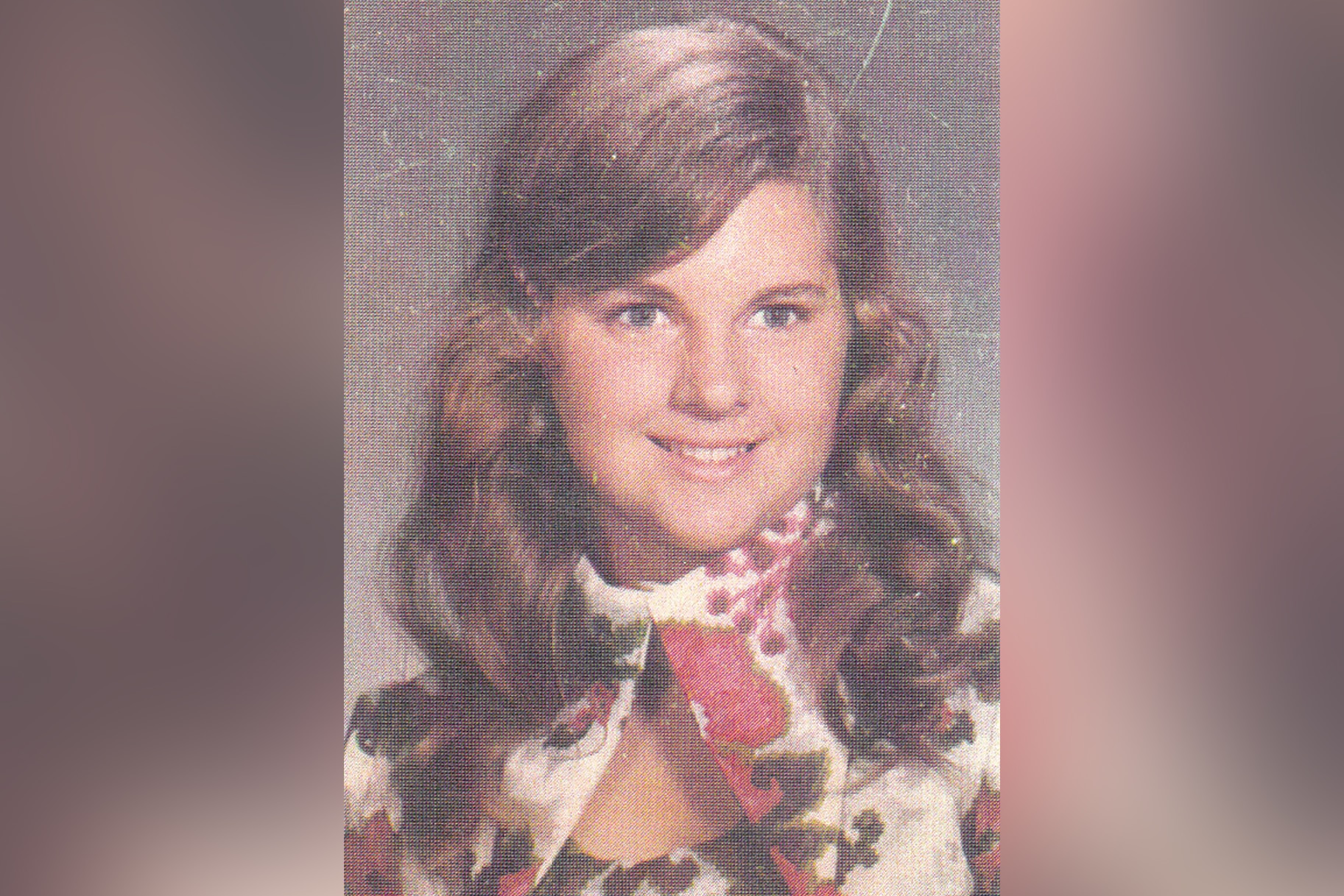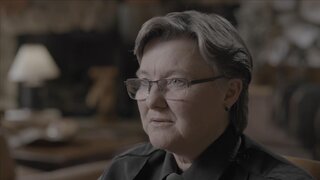Create a free profile to get unlimited access to exclusive videos, breaking news, sweepstakes, and more!
A Flat Tire Helps Crack The Case Of Missing Mother In California
Boyfriends and serial killers were just a couple of theories surrounding the 1987 disappearance of Vickie Eddington.

A mother’s car was found on the side of the road — and a flat tire would help authorities find her body several years later.
In 1987, Vickie Eddington, 29, resided in the small town of Jamul in the Californian desert. The San Diego-born woman lived with her husband, US Navy sailor Leonard Eddington, whom she married as a teenager back in 1975. Together, they shared three children.
“Leonard wanted to go to dinners and the dances in order to advance his career, and he wanted Vickie to be a wife that would support that kind of activity,” Vickie’s brother, Larry Vess, told “Buried in The Backyard,” airing Thursdays at 8/7c on Oxygen. “And Vickie was her own woman, and I think that’s where some of the problems that they had in their marriage started out.”
By 1987, the couple had separated, with Leonard moving into a trailer home on his mother’s property just next door. With Leonard’s help, Vickie primarily cared for the children while enrolled in nursing school.
Things went sideways on July 23, 1987. Leonard made a frantic call to authorities and reported that while on his way to drop their children off to swim lessons at the YMCA, he’d found Vickie’s station wagon on the side of a desolate road about four miles from their homes. One of its tires was flat.
Leonard also told authorities that after dropping the kids off, he returned home and called Vickie’s place of work, learning his wife didn’t show up at the hospital the night before.
“After she went missing, it was high stress,” said Vess. “Vickie was not the kind of person who would disappear. She would have found a way to reach out, or we would know more. You can tell when things aren’t right.”
Authorities chased a lead after learning Vickie might have found help at a local convenience store.
“The worker indicated that a female came into the store that evening, complaining that she had received a flat tire,” said former San Diego County prosecutor Jeff Dusek. “She had $20; she wanted change to make a call for somebody to come help her.”
When shown a photograph of Vickie Eddington, the employee thought it could be the same woman. Beyond that, no one knew where she went and whom she called, though Leonard confirmed Vickie never contacted him. Leonard did, however, tell authorities that she might have called someone else: her new boyfriend.
Detectives then looked into the alleged new boyfriend, an officer with the California Highway Patrol. But the boyfriend told them he and Vickie hadn’t dated in two years and that he’d since remarried. Authorities dug into the man’s story but determined he was at work when Vickie disappeared.
Investigators began to wonder if Vickie left of her own volition.
“Leonard said that Vickie told him that she just wanted to leave and disappear because she was stressed out and needed a break,” said retired Lt. Dennis Brugos of the San Diego County Sheriff’s Department.
After several dead ends, authorities turned their attention back to the hospital where Vickie worked, reassessing the call Leonard made to his wife’s job after he’d learned of her disappearance. Detectives discovered Leonard’s timeline didn’t quite match up.
“He said he did not see the car with the flat ‘til 7:30, and he did not drop his kids off at the YMCA ‘til 8:00,” said former prosecutor Dusek. “Which means he didn’t get back to the house ‘til 8:30 or so.”
But investigators learned Leonard made the calls to the hospital at around 7:00 a.m. The discovery prompted investigators to look deeper into Leonard Eddington.
Leonard also claimed he’d slept at Vickie’s house the night of her disappearance, but he couldn’t explain why he didn’t hear numerous phone calls made by the hospital to the home when colleagues tried to contact Vickie.
Although relatives and loved ones had their suspicions about Leonard, they had to remain copasetic for the sake of the children.
“It was very tense at times because we had to play nice in order to be with the children,” said Vickie’s sister-in-law, Sandy Vess.
After going on television to make a public appeal for his wife’s whereabouts, Leonard continued to draw suspicion when a woman reported she was engaged to Leonard when Vickie disappeared. Leonard told the woman he’d been divorced for several years. It opened the door for detectives, who learned that Leonard had several encounters with other women.
Although it painted Leonard in a negative light, it wasn’t enough for authorities to accuse him of foul play. But one year after Vickie vanished from Jamul, investigators look into a new possibility: that Vickie could have fallen prey to a serial killer.
“At the time, there was a series of bodies of women being found in the east county portion of San Diego,” said Dusek. “A lot of them [were] prostitutes, runaways, hitchhikers.”
No connection, however, was made between Vickie and the murder victims. Authorities cited the timeline as a mere coincidence.
In 1991, Vickie’s case was renewed when Lt. Brugos, looking into a separate Jane Doe, heard about Vickie Eddington for the first time. Brugos also became suspicious of Vickie’s estranged husband, Leonard. Learning that there was no wear on Vickie’s flat tire, as would be expected, investigators turned their attention back to Vickie’s car.
“That made me decide that the tire should be sent back to the manufacturer for examination,” said Brugos. “And their experts said that the flat was not the result of any type of road damage.”
Two seemingly deliberate puncture holes were found within the tire. Investigators also noted Leonard’s fingerprints were on the spare tire, car jack, inside the vehicle’s door, and the frame used to conceal the spare tire.
Re-canvassing the community, a neighbor told Lt. Brugos that Leonard used a digger to fill in a ravine in the backyard about two months after Vickie’s disappearance. Leonard told neighbors he planned on putting a mobile home on the property, though he never finished the task.
Investigators obtained a search warrant for the Eddington property. On Dec. 21, 1991, authorities went to the home. One of the female officers took the children into a separate room as authorities searched the residence. One of the kids made a damning statement to the officer.
“When she got to the children, she explained who she was,” said Dusek. “And the youngest child, I think she was 4 years old at the time, told her, ‘I know why you’re here. You think my mom’s buried in the backyard.’”
Authorities searched the hole Leonard filled in the backyard shortly after Vickie’s disappearance and discovered a portion of a chain-link fence. Beneath it, they found skeletal remains wrapped in a blanket.
Dental records confirmed it was the body of Vickie Eddington. The medical examiner listed her cause of death as blunt force trauma to the head.
“I was numb,” said Vickie’s brother,Larry Vess. “But it was a relief when I heard that they had found her. I knew that we could put her to rest and that we could move on from that point.”
Leonard claimed he was at Vickie’s home on the night she died on a consensual basis. After she went to rest for a few hours before her night shift at the hospital, he beat her to death as she slept in bed. Their children were asleep in adjacent rooms.
Prosecutors alleged Leonard drove Vickie’s car four miles home and staged a breakdown before walking back to the property.
The case of the mysterious woman who entered the convenience store and reported a flat tire turned out to be nothing but a coincidence.
“Ultimately, we were able to locate a woman who looked like Vickie and claimed she went to that 7-11, either that night or close to that night, claiming she had a flat tire and she needed change to call somebody for [the] flat,” said Dusek.
In 1992, a jury found Leonard Eddington guilty of murder. Prosecutors claimed he killed her to avoid a messy divorce.
“Instead of doing that, he made her disappear,” Dusek continued.
Leonard was sentenced to life in prison without the possibility of parole. He is currently incarcerated at the California Health Care Facility in Stockton.
For more on this case and others like it, watch "Buried In The Backyard," airing Thursdays at 8/7c on Oxygen, or stream episodes here.


















